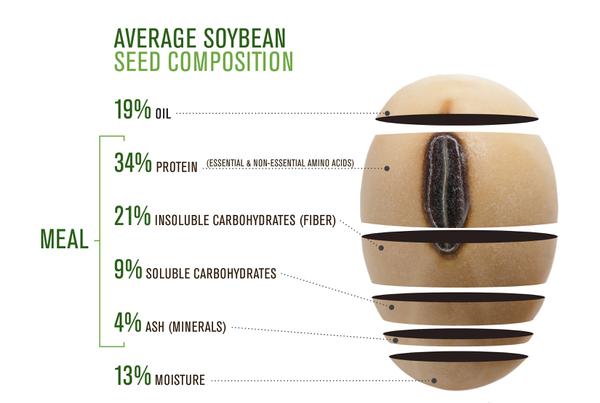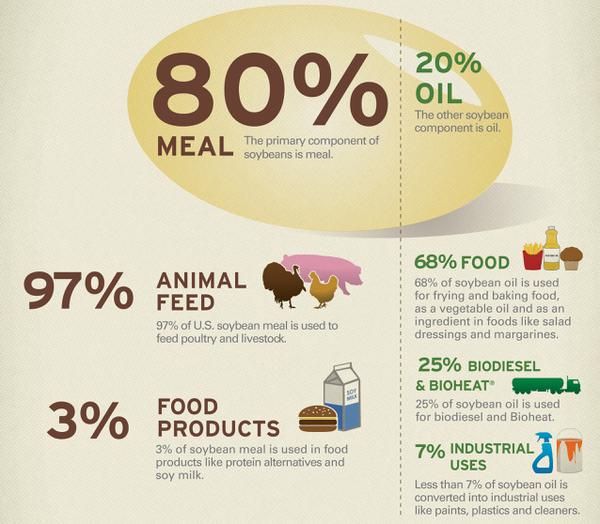Scientific Name: Glycine max
Family: Leguminosae (Legume)
Flower Colors: Purple, white
Seed Colors: Yellow, brown, black green, bicolored, variegated
Hilum Colors: Buff (colorless), black, imperfect black, brown
Pubescence Colors: Tawny (golden brown), gray
Plant Height: 20 inches to 50 inches (varies by variety and environmental conditions)
Pod Number: 0 to 400 per plant
Seed/Pod: 1 to 5; 2 to 3 more common
Hypocotyl Color: Green, purple
1 bushel = 60 pounds
1 hundredweight = 1.66 bushels
1 short ton = 33.33 bushels
1 metric ton = 2,204.6 pounds
1 metric ton = 36.7 bushels soybeans
1 short ton = 0.907 metric ton
1 hectare = 2.471 acres
1 acre = 0.405 hectares
34 bushel/acre soybeans = 2.29 metric tons/hectare
Protein content of seed » 36 ± 2%
Oil content of seed » 18 ± 2%
1 bushel = 11 pounds of oil
1 bushel = 48 pounds of protein-rich meal
Seed Composition
Soybeans are processed by cleaning, cracking, dehulling, and rolling them into flakes. This process ruptures the oil cells for efficient extraction to separate the oil and meal components. After removal of the oil, the reaming flakes are used to produce soybean meal. The mature soybean is about 19% oil, 34% protein, 30% carbohydrate, and 17% moisture, ash, and hull (Figure 12-1). The dehulled meal contains about 48% protein. Soybeans are the only vegetable that contain complete protein.
Major Uses
Soybeans are a versatile and renewable crop that help meet food, feed, and fuel demand around the world. Soybeans are approximately 20% oil and 80% meal. Most soybeans are processed for the animal feed industry but they are also used for human food products, fuel, and industrial products (Figure 12-2).
Grade Specifications
The United States Grain Inspection, Packers & Stockyards Administration (GIPSA) defines soybeans as grain that consists of 50% or more of whole or broken soybeans that will not pass through an 8⁄64 round-hole sieve and not more than 10% of other grains. Grading factors can be found in table 12-1.
Table 12-1. Grading factors and US soybean grade numbers.
|
Grading factors |
Criteria |
Grades U.S. Nos. |
|||
|---|---|---|---|---|---|
|
1 |
2 |
3 |
4 |
||
|
Maximum percent limits of |
Damaged kernels: heat (part of total) |
2.0 |
3.0 |
1.0 |
3.0 |
|
Damaged kernels: total |
1.0 |
2.0 |
5.0 |
8.0 |
|
|
Foreign material |
10.0 |
20.0 |
3.0 |
5.0 |
|
|
Splits |
1.0 |
2.0 |
30.0 |
40.0 |
|
|
Soybeans of other colors1 |
2.0 |
3.0 |
5.0 |
10.0 |
|
|
Maximum count limits of |
Animal filth |
9 |
9 |
9 |
9 |
|
Castor beans |
1 |
1 |
1 |
1 |
|
|
Crotalaria seeds Glass |
2 |
2 |
2 |
2 |
|
|
Stones2 |
0 |
0 |
0 |
0 |
|
|
Unknown foreign substance |
3 |
3 |
3 |
3 |
|
|
Total3 |
3 |
3 |
3 |
3 |
|
|
Animal filth |
10 |
10 |
10 |
10 |
|
Note: U.S. Sample Grade are soybeans that:
(a) Do not meet the requirements for U.S. Nos. 1, 2, 3, or 4; or
(b) Have a musty, sour, or commercially objectionable foreign odor (except garlic odor); or
(c) Are heating or otherwise of distinctly low quality.
1 Disregard for mixed soybeans.
2 In addition to the maximum count limit, stones must exceed 0.1% of the sample weight.
3 Includes any combination of animal filth, castor beans, crotalaria seeds, glass, stones, and unknown foreign substances. The weight of stones is not applicable for total other material.
Source: USDA, Grain Inspection, Packers & Stockyard Administration
Publication date: April 29, 2022
AG-835
Other Publications in North Carolina Soybean Production Guide
- The Soybean Plant
- Soybean Production and Marketing in North Carolina
- Rotational Considerations
- Variety Selection
- Planting Decisions
- Fertilization and Nutrient Management
- Weed Management
- Disease and Nematode Management
- Insect Management
- Key Management Strategies to Increase North Carolina Soybean Yield: What We Have Learned From 877 Soybean Yield Contest Entries
- Harvesting, Drying, and Storage
- Soybean Facts
Recommendations for the use of agricultural chemicals are included in this publication as a convenience to the reader. The use of brand names and any mention or listing of commercial products or services in this publication does not imply endorsement by NC State University or N.C. A&T State University nor discrimination against similar products or services not mentioned. Individuals who use agricultural chemicals are responsible for ensuring that the intended use complies with current regulations and conforms to the product label. Be sure to obtain current information about usage regulations and examine a current product label before applying any chemical. For assistance, contact your local N.C. Cooperative Extension county center.
N.C. Cooperative Extension prohibits discrimination and harassment regardless of age, color, disability, family and marital status, gender identity, national origin, political beliefs, race, religion, sex (including pregnancy), sexual orientation and veteran status.


